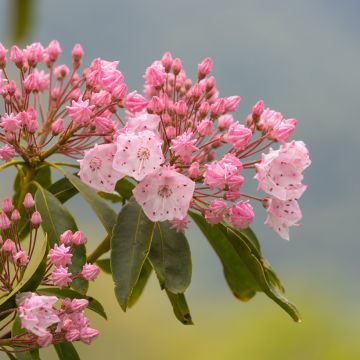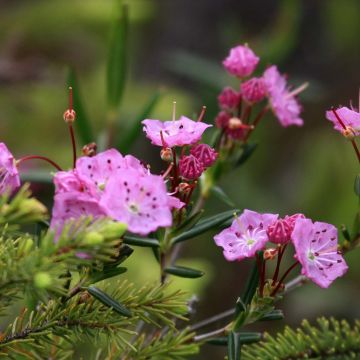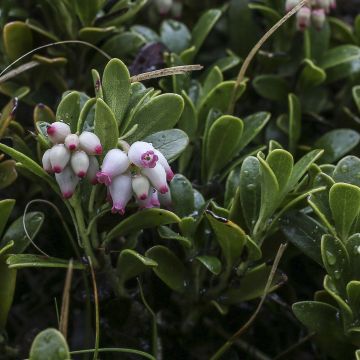

Kalmia latifolia Ideal - Mountain Laurel
Kalmia latifolia Ideal - Mountain Laurel
Kalmia latifolia Ideal
Mountain Laurel, Calico Bush, Spoonwood
Plant arrived in perfect condition, well protected, as always
Martine, 24/05/2025
Special offer!
Receive a €20 voucher for any order over €90 (excluding delivery costs, credit notes, and plastic-free options)!
1- Add your favorite plants to your cart.
2- Once you have reached €90, confirm your order (you can even choose the delivery date!).
3- As soon as your order is shipped, you will receive an email containing your voucher code, valid for 3 months (90 days).
Your voucher is unique and can only be used once, for any order with a minimum value of €20, excluding delivery costs.
Can be combined with other current offers, non-divisible and non-refundable.
Home or relay delivery (depending on size and destination)
Schedule delivery date,
and select date in basket
This plant carries a 24 months recovery warranty
More information
We guarantee the quality of our plants for a full growing cycle, and will replace at our expense any plant that fails to recover under normal climatic and planting conditions.

Would this plant suit my garden?
Set up your Plantfit profile →
Description
The Kalmia latifolia 'Ideal' is an evergreen heather soil bush that offers one of the most beautiful spring flowerings. In May-June, its floral buds, produced well in advance, open up to form lovely bell-shaped flowers, larger than many other varieties. With a pale pink color, the floral corollas are enhanced by reddish-purple speckles arranged in a peripheral circle. The flowering, exuding a true romantic charm, is magnified by the shiny dark green foliage, which persists all year round. A superb bush still too little planted, it appreciates cool and semi-shady situations and is not afraid of the cold.
Kalmia is a member of the Ericaceae family, which includes about a hundred genera, many of which are ornamental (Rhododendron, Heathers, Leucothoe...) and some produce edible fruits (Blueberry, Strawberry Tree...). The genus Kalmia, commonly known as Mountain Laurel, boasts about twenty species native to North America. Kalmia latifolia thus grows wild in the oak and pine forests of the eastern Canadian mountains (Quebec and New Brunswick) and the eastern United States, descending as far as Florida. In these regions, it can form a small tree up to 12 m high, but in our parks and gardens, it does not exceed 2 to 3 m and often less.
'Ideal' is a horticultural hybrid obtained in 2001 by the German breeder Karl-Heinz Hübbers by crossing the varieties 'Mitternacht' and 'Ginkona'. The result of this crossbreeding was registered in 2013 to be released on the market. The fairly slow-growing bush forms, in ten years of planting, an irregular clump of approximately 1.10-1.20 m in height by 0.80 m in width. It has an upright habit, with somewhat stiff, upright branches, green streaked with reddish. The leaves measure up to 10 cm long by 4 cm wide, are dark green with a smooth and glossy surface, while the edges may slightly undulate. They are carried by short 2 cm long petioles. This somewhat dark evergreen vegetation forms a perfect setting for the flowering. The dark pink floral buds are already very decorative before the flowers bloom in May and June. Gathered in corymbs about a dozen centimeters long, the numerous flowers (several tens) open gradually one after the other, half-open bell-shaped flowers coexisting with fully open flowers, forming cups up to 3.5 cm in diameter. Their light pink color is absolutely delightful and, a touch of coquetry, reddish-purple speckles are arranged to form a mottled border, further enhancing their beauty. The corolla consists of five fused petals (referred to as gamopetalous flowers), 10 discreet stamens, and a protruding pistil. In full bloom towards the end of May, the Kalmia can compete with many other flowering shrubs.
The Kalmia 'Ideal' is a very attractive bush, quite demanding in its growing conditions, not tolerating limestone, full sun, and even less drought. However, when its needs are met, it is a plant of great beauty that offers a rare spectacle in spring. Plant it alongside the Andromeda polifolia 'Blue Ice', a charming shrub that, planted at its base, will create a nice and soft contrast of foliage thanks to its small silver-gray leaves. Its small pink bell-shaped flowers will perfectly complement the bells of your Mountain Laurel. A few plants of Japanese Primrose 'Millers Crimson' in the foreground will also be welcome, while a Japanese Maple 'Dissectum Garnet' with its very finely cut dark red foliage will have a beautiful effect behind 'Ideal'.
Beware of children and pets, all parts of the plant are toxic (leaves, buds, and flowers).
Report an error about the product description
Kalmia latifolia Ideal - Mountain Laurel in pictures


Plant habit
Flowering
Foliage
Safety measures
Botanical data
Kalmia
latifolia
Ideal
Ericaceae
Mountain Laurel, Calico Bush, Spoonwood
Cultivar or hybrid
ingestion
Cette plante est toxique si elle est ingérée volontairement ou involontairement.
Ne la plantez pas là où de jeunes enfants peuvent évoluer, et lavez-vous les mains après l'avoir manipulée.
Pensez à conserver l'étiquette de la plante, à la photographier ou à noter son nom, afin de faciliter le travail des professionnels de santé.
Davantage d'informations sur https://plantes-risque.info
Other Kalmias
View all →Planting and care
Originating from the mountains of the Eastern North America, the Kalmia latifolia is extremely hardy and can withstand very low temperatures, down to -20°C. It requires to be planted in a semi-shaded exposure, in a humus-bearing and fertile, acidic, fresh (even moist) but well-drained soil. For planting, avoid frosty or extremely hot periods, but rather favour those of spring or autumn rains, which will facilitate its establishment. Plan for a fairly wide and deep hole (40 cm by 40 cm) for your Kalmia to settle in permanently. Regular watering (with non-limestone water if possible) in the first weeks following planting is necessary to keep the soil moist and fresh. Mulching at the base can be beneficial to protect the fine and superficial roots. Every spring, loosen the soil around the base and top dress with a mix of compost, heather soil, and pine bark. If the soil is limestone, it will be necessary to avoid planting this acid-loving bush, which may deteriorate in the long term. However, you can attempt its cultivation by replacing your garden soil (within 60 to 80 cm all around) with a mix of heather soil, leaf compost, and peat. In this case, provide dissolved iron chelate in the irrigation water every three months, from spring to autumn.
The Mountain Laurel can tolerate a sunny exposure, but fears scorching situations and drought. It must be placed in such a way that it is shaded during the hottest hours of the day, and mulching the base is necessary to preserve soil freshness. During the summer period and especially in case of drought, regular watering (preferably with rainwater) will be essential. Summer watering is particularly important as floral buds form for the following spring. The Mountain Laurel, loving coolness and high humidity, will thrive in an oceanic or rainy climate. It can also be grown in a large container on the terrace or balcony. The risks of soil drying out are higher in pot cultivation, thus a large container along with mulching, to retain freshness, and increased monitoring of watering will be necessary. Prefer plastic pots with "double skin" (with an insulating air layer between the two layers) or thick terracotta to promote thermal inertia and prevent harmful soil heating. Apart from removing faded flowers, pruning of Kalmia latifolia is hardly necessary. In fact, it may hinder next year's flowering, as floral buds form at the ends of the branches. However, it is possible to remove dead wood and lightly refresh to maintain a balanced habit of the Kalmia.
Planting period
Intended location
Care
-
, onOrder confirmed
Reply from on Promesse de fleurs
Similar products
Haven't found what you were looking for?
Hardiness is the lowest winter temperature a plant can endure without suffering serious damage or even dying. However, hardiness is affected by location (a sheltered area, such as a patio), protection (winter cover) and soil type (hardiness is improved by well-drained soil).

Photo Sharing Terms & Conditions
In order to encourage gardeners to interact and share their experiences, Promesse de fleurs offers various media enabling content to be uploaded onto its Site - in particular via the ‘Photo sharing’ module.
The User agrees to refrain from:
- Posting any content that is illegal, prejudicial, insulting, racist, inciteful to hatred, revisionist, contrary to public decency, that infringes on privacy or on the privacy rights of third parties, in particular the publicity rights of persons and goods, intellectual property rights, or the right to privacy.
- Submitting content on behalf of a third party;
- Impersonate the identity of a third party and/or publish any personal information about a third party;
In general, the User undertakes to refrain from any unethical behaviour.
All Content (in particular text, comments, files, images, photos, videos, creative works, etc.), which may be subject to property or intellectual property rights, image or other private rights, shall remain the property of the User, subject to the limited rights granted by the terms of the licence granted by Promesse de fleurs as stated below. Users are at liberty to publish or not to publish such Content on the Site, notably via the ‘Photo Sharing’ facility, and accept that this Content shall be made public and freely accessible, notably on the Internet.
Users further acknowledge, undertake to have ,and guarantee that they hold all necessary rights and permissions to publish such material on the Site, in particular with regard to the legislation in force pertaining to any privacy, property, intellectual property, image, or contractual rights, or rights of any other nature. By publishing such Content on the Site, Users acknowledge accepting full liability as publishers of the Content within the meaning of the law, and grant Promesse de fleurs, free of charge, an inclusive, worldwide licence for the said Content for the entire duration of its publication, including all reproduction, representation, up/downloading, displaying, performing, transmission, and storage rights.
Users also grant permission for their name to be linked to the Content and accept that this link may not always be made available.
By engaging in posting material, Users consent to their Content becoming automatically accessible on the Internet, in particular on other sites and/or blogs and/or web pages of the Promesse de fleurs site, including in particular social pages and the Promesse de fleurs catalogue.
Users may secure the removal of entrusted content free of charge by issuing a simple request via our contact form.
The flowering period indicated on our website applies to countries and regions located in USDA zone 8 (France, the United Kingdom, Ireland, the Netherlands, etc.)
It will vary according to where you live:
- In zones 9 to 10 (Italy, Spain, Greece, etc.), flowering will occur about 2 to 4 weeks earlier.
- In zones 6 to 7 (Germany, Poland, Slovenia, and lower mountainous regions), flowering will be delayed by 2 to 3 weeks.
- In zone 5 (Central Europe, Scandinavia), blooming will be delayed by 3 to 5 weeks.
In temperate climates, pruning of spring-flowering shrubs (forsythia, spireas, etc.) should be done just after flowering.
Pruning of summer-flowering shrubs (Indian Lilac, Perovskia, etc.) can be done in winter or spring.
In cold regions as well as with frost-sensitive plants, avoid pruning too early when severe frosts may still occur.
The planting period indicated on our website applies to countries and regions located in USDA zone 8 (France, United Kingdom, Ireland, Netherlands).
It will vary according to where you live:
- In Mediterranean zones (Marseille, Madrid, Milan, etc.), autumn and winter are the best planting periods.
- In continental zones (Strasbourg, Munich, Vienna, etc.), delay planting by 2 to 3 weeks in spring and bring it forward by 2 to 4 weeks in autumn.
- In mountainous regions (the Alps, Pyrenees, Carpathians, etc.), it is best to plant in late spring (May-June) or late summer (August-September).
The harvesting period indicated on our website applies to countries and regions in USDA zone 8 (France, England, Ireland, the Netherlands).
In colder areas (Scandinavia, Poland, Austria...) fruit and vegetable harvests are likely to be delayed by 3-4 weeks.
In warmer areas (Italy, Spain, Greece, etc.), harvesting will probably take place earlier, depending on weather conditions.
The sowing periods indicated on our website apply to countries and regions within USDA Zone 8 (France, UK, Ireland, Netherlands).
In colder areas (Scandinavia, Poland, Austria...), delay any outdoor sowing by 3-4 weeks, or sow under glass.
In warmer climes (Italy, Spain, Greece, etc.), bring outdoor sowing forward by a few weeks.













































